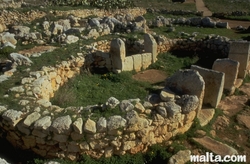Prehistory about Malta: discover the old history of the Maltese Islands
 Malta's first settlers
Malta's first settlers
It seems that the Maltese islands were first inhabited around 5200 BC by Stone Age hunters or farmers who made their way to Malta from Sicily using rafts.
This time period was suggested after pre-historical pottery was found by archaeologists at Skorba, resembling pottery found in Italy.
It is therefore presumed that the settlers were probably the Sicani, the prehistoric people of Sicily.
When they arrived in Malta they first settled in caves, such as Għar Dalam and later they built huts for protection.
Age of Temple building around Malta
Once the Sicani settled in Malta they started to grow cereals and raised livestock. They built an advanced society, used simple tools made out of stone and wood and worshipped fertility figures (Mother goddesses), such as the Venus of Willendorf.
This was a culture of megalithic temple builders who built some of the oldest structures in the world that still exist. These megalithic wonders are Hagar Qim and Mnajdra in Malta, and Ġgantija temples in Gozo. Information suggests that animal sacrifices were made in the temples to the goddess of fertility after knifes and bones were find behind an altar stone. The gigantic mother goddess statue is now in the National Museum of Archaeology in Valletta.
Malta during the Bronze Age
At around 2500 BC, this advanced, temple building society vanished from Malta, most likely due to disease or starvation. The only archaeological evidences found in this period on the Maltese islands are the so-called “cart tracks" or "cart ruts”. These are prehistoric channels thought to have been caused by wooden-wheeled carts wearing away the soft limestone. Cart tracks can be found in several places throughout the islands, for example between Dingli Cliffs and Buskett with the name “Clapham Junction”.
After 2500 BC, the Maltese Islands were uninhabited for several decades. The new settlers were a new tribe of Bronze Age people who brought with them the knowledge to build smaller megalithic structures called dolmens, and also the new culture of cremating the dead.


